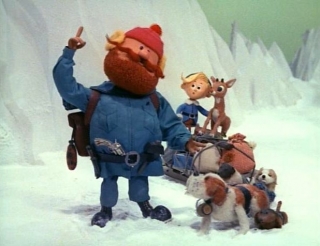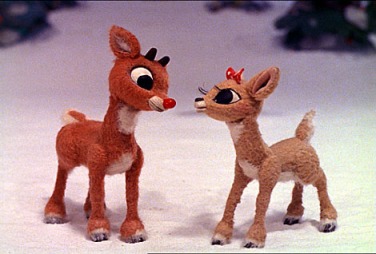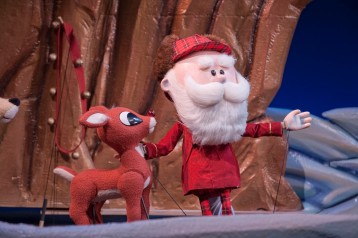This is the fourth in a series of posts, The Twelve Days of Christmas Movies. Each one will review/talk about a different Christmassy film and the whole thing spans 12 days – one film per day. You can read the original post about it (which also lists all 12 days of movies) here.
Hello there! Welcome to the fourth day of the Twelve Days of Christmas Movies! Today we are going to be taking a look at Rudolph, The Red-Nosed Reindeer – the 1964 TV film, to be specific. Now it was only about an hour long, so I might not have a lot to say about it. I know A Charlie Brown Christmas was even shorter than that, but we all know how long you can end up writing for when you go off on a rant, like I did that time. We’ll see how we go.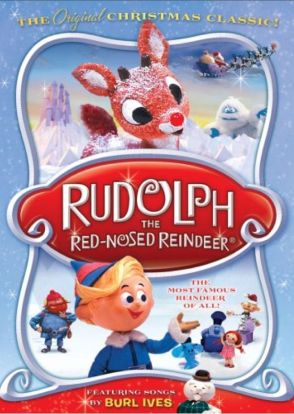
Anyway, I’ve mentioned before that I never really liked Rudolph. Seeing as that comment has probably spawned a thousand-strong internet hate group dedicated to converting me to the side of the red-nosed reindeer (not really – I don’t think that many people read my blog), I should probably explain a bit. So why didn’t I like Rudolph? For one thing, he’s the most commercial reindeer*. Instead of being a “traditional” reindeer like Dasher, Blitzen, Vixen, and so on, Rudolph was created by Robert L. May in order to be part of a Christmas-themed colouring book. That’s not the most important part of why I didn’t like Rudolph, though. The other part is the moral (or lack thereof) of his story. Basically, it always came across to me as: “Gain the approval of a big kahuna like Santa Claus, and suddenly everyone will want to be friends with you, regardless of how mean or disapproving they were towards you previously. This will make you happy.”
What a good moral. Because what we all need are children growing up desperately seeking acceptance by the people who are cruel to them, and only embracing the unique qualities that separate them from their peers if they are useful in a situation that is considered respectful by society. And apparently I’ve started ranting again.
So we’ve established the fact that I never really liked Rudolph, but the film I watched today managed to put a refreshing spin on the usual story of everyone’s favourite underdog reindeer. Although the typical tale of Rudolph involves him being rejected only by his friends, this movie took the somewhat darker stance of showing Rudolph being shunned by not only his peers, but also by his family and the entire Christmas Town community, as well.
In Rudolph, The Red-Nosed Reindeer, the eponymous protagonist is the son of Donner and Mrs Donner (it doesn’t make sense to me, either). When he is born and his parents see his glowing red nose, Donner’s immediate reaction is to cover it up somehow. Mrs Donner, who is a little more accepting, says that they “will simply have to overlook it”. Santa inexplicably sees it as a reason Rudolph will be unable to join his sleigh team, and even tells Donner that he “should be ashamed” of himself for having a son with a glowing nose. The concept of a physical trait that nobody, not even one’s parents, would accept is a rather dark – even slightly disturbing – idea, especially for children. In this situation, I had far more sympathy for poor Rudolph than in any previous adaptation.
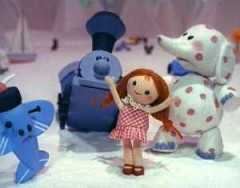 Whilst Rudolph’s parents are trying desperately to conceal his nose, an elf who wants to be a dentist is being ridiculed for not being good at making toys. This elf, called Hermey, eventually quits his job as toy maker and meets Rudolph. The latter has recently been exiled from the Reindeer Games (in this film, these are a sort of sports training for young reindeer), and when he meets Hermey, Rudolph is delighted to meet a fellow outcast. Both feeling unaccepted and unwanted in Christmas Town, Rudolph and Hermey leave. Although neither seem to know exactly where they’re going, the overall idea seems to be that they’re trying to find somewhere they’ll be welcome.
Whilst Rudolph’s parents are trying desperately to conceal his nose, an elf who wants to be a dentist is being ridiculed for not being good at making toys. This elf, called Hermey, eventually quits his job as toy maker and meets Rudolph. The latter has recently been exiled from the Reindeer Games (in this film, these are a sort of sports training for young reindeer), and when he meets Hermey, Rudolph is delighted to meet a fellow outcast. Both feeling unaccepted and unwanted in Christmas Town, Rudolph and Hermey leave. Although neither seem to know exactly where they’re going, the overall idea seems to be that they’re trying to find somewhere they’ll be welcome.
One of the things I really liked about this film (other than the way they portrayed Rudolph’s backstory) is their portrayal of the North Pole, especially Christmas Town. In Rudolph, The Red-Nosed Reindeer, the way they show Christmas Town is somewhat more “realistic”. The film-makers show how the children of the reigning sleigh-pulling reindeer are trained at the Reindeer Games and raised to become the sleigh-pullers of tomorrow. The film also shows the elves making the toys, coming up with Christmas songs, and being ordered about by authority figures in a less magical way than is often shown. They even show Mrs Claus practically force-feeding Santa in an attempt to get him fatter in time for Christmas Eve. After all, the children “expect a fat Santa”.
Another part I really liked was the redemption of an antagonistic character. I won’t say which one I’m talking about in particular – although it will probably be blatantly obvious after watching the first 5 minutes of the movie – because I don’t want to spoil it. On the other hand, I will say that after surviving what is technically both a Disney Villain Death and a variation on the plain old Disney Death, they come back and are given a positive role in Christmas Town. I love it when stories show a “bad” character turning around and becoming good, rather than having their evil presence resolved through their death. This is yet another example of how Rudolph, The Red-Nosed Reindeer presents slightly more unique, karmic morals than are often presented in children’s films.
Not that there aren’t issues with the film, of course. You can sort of tell that it was made in 1964 due to the vaguely sexist attitudes present, such as Donner saying his wife should not try to join in the hunt for Rudolph, as “this is man’s work”. On top of that, Mrs Donner and Clarice (Rudolph’s doe friend) play the roles of damsels-in-distress at least once. Upon their (minor spoiler, highlight to view) rescue, the narrator comments that the men realised “that the best thing to do is to get the women back to Christmas Town”. But the real question is: Why were they out of the kitchen in the first place?
So on a whole, I really liked Rudolph, The Red-Nosed Reindeer. I think I like the main character more after watching it, and would certainly watch it again. I thought it was great that the film-makers put a twist on the usual moral of Rudolph’s story, plus the additional plot line of The Island of Misfit Toys is a lovely inclusion. It also has a nice message without appealing especially to any particular denomination, which means that any person with a heart has a good chance of getting some enjoyment out of the film. In summary: this film is wonderful – go watch it.
Overall rating: 8/10
Christmassy-ness rating: 8/10 (perhaps less Christmassy and more North Pole-y, but still has plenty of Christmas symbols and plot relations)
Mary’s parental guidance rating: PG (simply for the fact that some children might be upset by how Rudolph is treated)
Tomorrow’s film: Jingle All the Way
*Charlie Brown’s anti-commercialism is rubbing off on me.
Note: In the first Twelve Days of Christmas post, which you can read here, I mentioned about Baby New Year’s role in this movie. I also thought that this film was the source of my knowing the word “eon/aeon”. Well, as it turns out, I was wrong again. The film I was thinking of was Rudolph’s Shiny New Year, a sequel to the film I watched today. Once again, Mary fails to check her facts. I guess Rudolph’s Shiny New Year will just have to be on the Twelve Days of New Year Movies list.

